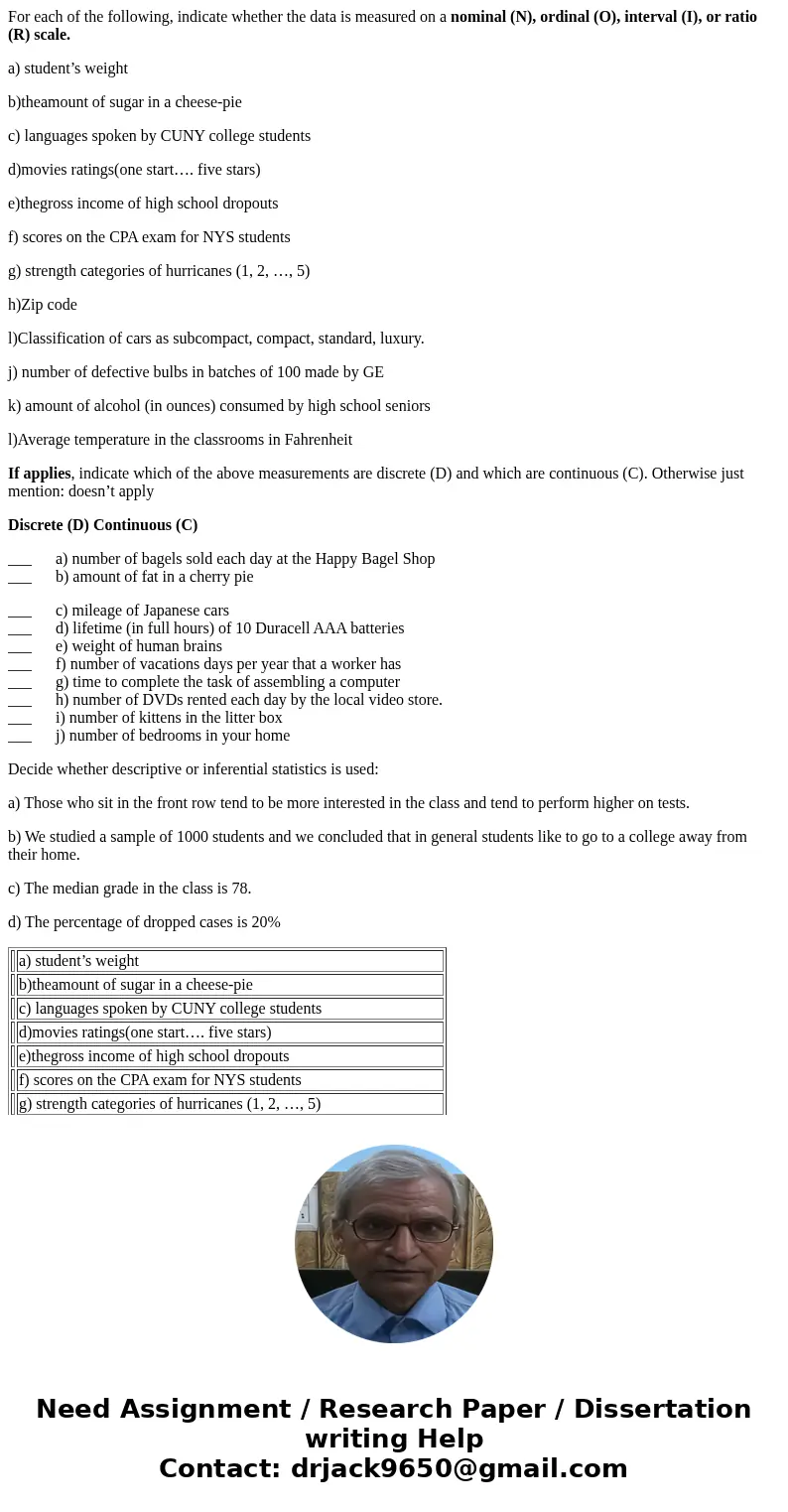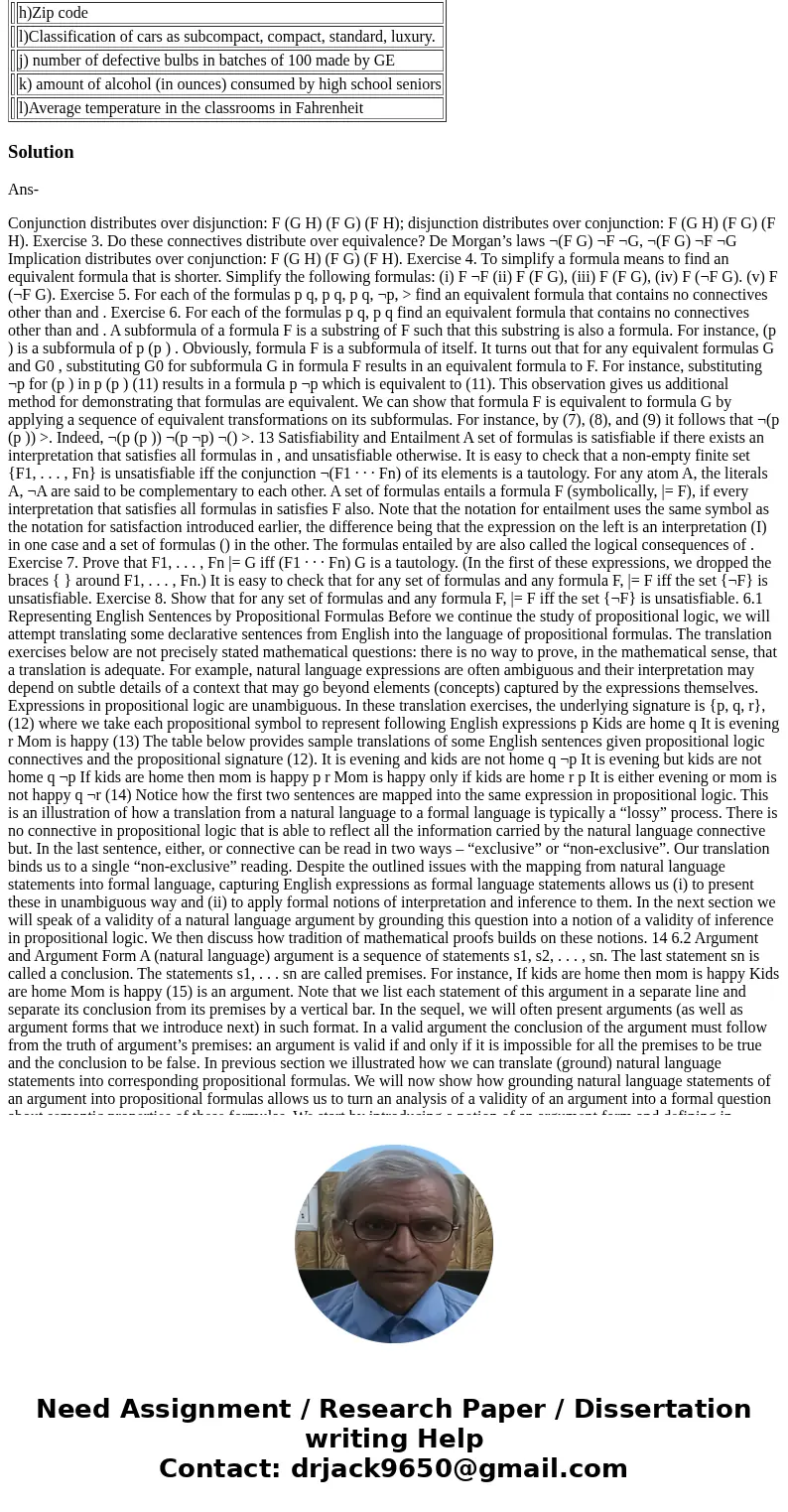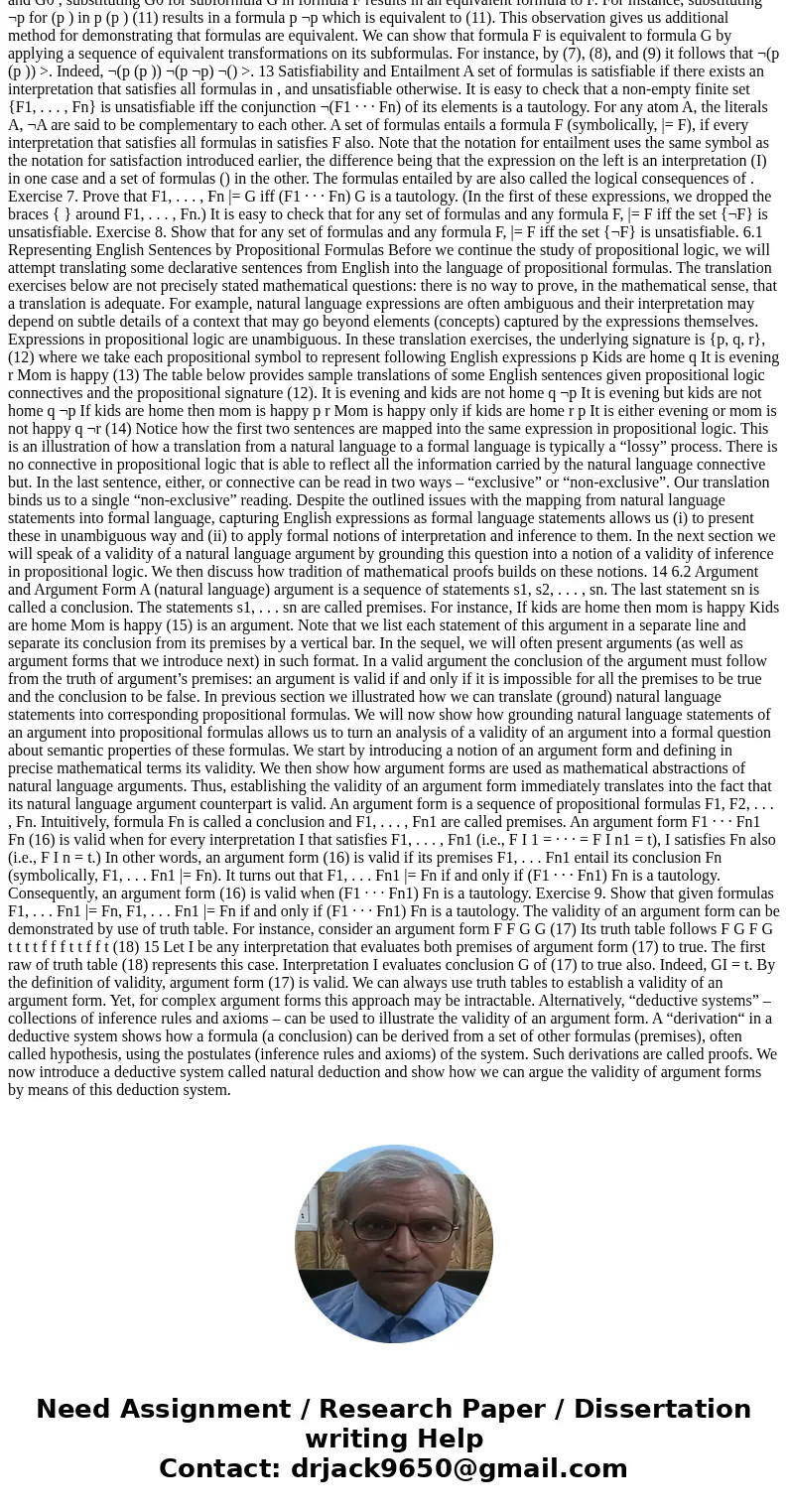For each of the following indicate whether the data is measu
For each of the following, indicate whether the data is measured on a nominal (N), ordinal (O), interval (I), or ratio (R) scale.
a) student’s weight
b)theamount of sugar in a cheese-pie
c) languages spoken by CUNY college students
d)movies ratings(one start…. five stars)
e)thegross income of high school dropouts
f) scores on the CPA exam for NYS students
g) strength categories of hurricanes (1, 2, …, 5)
h)Zip code
l)Classification of cars as subcompact, compact, standard, luxury.
j) number of defective bulbs in batches of 100 made by GE
k) amount of alcohol (in ounces) consumed by high school seniors
l)Average temperature in the classrooms in Fahrenheit
If applies, indicate which of the above measurements are discrete (D) and which are continuous (C). Otherwise just mention: doesn’t apply
Discrete (D) Continuous (C)
___ a) number of bagels sold each day at the Happy Bagel Shop
___ b) amount of fat in a cherry pie
___ c) mileage of Japanese cars
___ d) lifetime (in full hours) of 10 Duracell AAA batteries
___ e) weight of human brains
___ f) number of vacations days per year that a worker has
___ g) time to complete the task of assembling a computer
___ h) number of DVDs rented each day by the local video store.
___ i) number of kittens in the litter box
___ j) number of bedrooms in your home
Decide whether descriptive or inferential statistics is used:
a) Those who sit in the front row tend to be more interested in the class and tend to perform higher on tests.
b) We studied a sample of 1000 students and we concluded that in general students like to go to a college away from their home.
c) The median grade in the class is 78.
d) The percentage of dropped cases is 20%
| a) student’s weight | |
| b)theamount of sugar in a cheese-pie | |
| c) languages spoken by CUNY college students | |
| d)movies ratings(one start…. five stars) | |
| e)thegross income of high school dropouts | |
| f) scores on the CPA exam for NYS students | |
| g) strength categories of hurricanes (1, 2, …, 5) | |
| h)Zip code | |
| l)Classification of cars as subcompact, compact, standard, luxury. | |
| j) number of defective bulbs in batches of 100 made by GE | |
| k) amount of alcohol (in ounces) consumed by high school seniors | |
| l)Average temperature in the classrooms in Fahrenheit |
Solution
Ans-
Conjunction distributes over disjunction: F (G H) (F G) (F H); disjunction distributes over conjunction: F (G H) (F G) (F H). Exercise 3. Do these connectives distribute over equivalence? De Morgan’s laws ¬(F G) ¬F ¬G, ¬(F G) ¬F ¬G Implication distributes over conjunction: F (G H) (F G) (F H). Exercise 4. To simplify a formula means to find an equivalent formula that is shorter. Simplify the following formulas: (i) F ¬F (ii) F (F G), (iii) F (F G), (iv) F (¬F G). (v) F (¬F G). Exercise 5. For each of the formulas p q, p q, p q, ¬p, > find an equivalent formula that contains no connectives other than and . Exercise 6. For each of the formulas p q, p q find an equivalent formula that contains no connectives other than and . A subformula of a formula F is a substring of F such that this substring is also a formula. For instance, (p ) is a subformula of p (p ) . Obviously, formula F is a subformula of itself. It turns out that for any equivalent formulas G and G0 , substituting G0 for subformula G in formula F results in an equivalent formula to F. For instance, substituting ¬p for (p ) in p (p ) (11) results in a formula p ¬p which is equivalent to (11). This observation gives us additional method for demonstrating that formulas are equivalent. We can show that formula F is equivalent to formula G by applying a sequence of equivalent transformations on its subformulas. For instance, by (7), (8), and (9) it follows that ¬(p (p )) >. Indeed, ¬(p (p )) ¬(p ¬p) ¬() >. 13 Satisfiability and Entailment A set of formulas is satisfiable if there exists an interpretation that satisfies all formulas in , and unsatisfiable otherwise. It is easy to check that a non-empty finite set {F1, . . . , Fn} is unsatisfiable iff the conjunction ¬(F1 · · · Fn) of its elements is a tautology. For any atom A, the literals A, ¬A are said to be complementary to each other. A set of formulas entails a formula F (symbolically, |= F), if every interpretation that satisfies all formulas in satisfies F also. Note that the notation for entailment uses the same symbol as the notation for satisfaction introduced earlier, the difference being that the expression on the left is an interpretation (I) in one case and a set of formulas () in the other. The formulas entailed by are also called the logical consequences of . Exercise 7. Prove that F1, . . . , Fn |= G iff (F1 · · · Fn) G is a tautology. (In the first of these expressions, we dropped the braces { } around F1, . . . , Fn.) It is easy to check that for any set of formulas and any formula F, |= F iff the set {¬F} is unsatisfiable. Exercise 8. Show that for any set of formulas and any formula F, |= F iff the set {¬F} is unsatisfiable. 6.1 Representing English Sentences by Propositional Formulas Before we continue the study of propositional logic, we will attempt translating some declarative sentences from English into the language of propositional formulas. The translation exercises below are not precisely stated mathematical questions: there is no way to prove, in the mathematical sense, that a translation is adequate. For example, natural language expressions are often ambiguous and their interpretation may depend on subtle details of a context that may go beyond elements (concepts) captured by the expressions themselves. Expressions in propositional logic are unambiguous. In these translation exercises, the underlying signature is {p, q, r}, (12) where we take each propositional symbol to represent following English expressions p Kids are home q It is evening r Mom is happy (13) The table below provides sample translations of some English sentences given propositional logic connectives and the propositional signature (12). It is evening and kids are not home q ¬p It is evening but kids are not home q ¬p If kids are home then mom is happy p r Mom is happy only if kids are home r p It is either evening or mom is not happy q ¬r (14) Notice how the first two sentences are mapped into the same expression in propositional logic. This is an illustration of how a translation from a natural language to a formal language is typically a “lossy” process. There is no connective in propositional logic that is able to reflect all the information carried by the natural language connective but. In the last sentence, either, or connective can be read in two ways – “exclusive” or “non-exclusive”. Our translation binds us to a single “non-exclusive” reading. Despite the outlined issues with the mapping from natural language statements into formal language, capturing English expressions as formal language statements allows us (i) to present these in unambiguous way and (ii) to apply formal notions of interpretation and inference to them. In the next section we will speak of a validity of a natural language argument by grounding this question into a notion of a validity of inference in propositional logic. We then discuss how tradition of mathematical proofs builds on these notions. 14 6.2 Argument and Argument Form A (natural language) argument is a sequence of statements s1, s2, . . . , sn. The last statement sn is called a conclusion. The statements s1, . . . sn are called premises. For instance, If kids are home then mom is happy Kids are home Mom is happy (15) is an argument. Note that we list each statement of this argument in a separate line and separate its conclusion from its premises by a vertical bar. In the sequel, we will often present arguments (as well as argument forms that we introduce next) in such format. In a valid argument the conclusion of the argument must follow from the truth of argument’s premises: an argument is valid if and only if it is impossible for all the premises to be true and the conclusion to be false. In previous section we illustrated how we can translate (ground) natural language statements into corresponding propositional formulas. We will now show how grounding natural language statements of an argument into propositional formulas allows us to turn an analysis of a validity of an argument into a formal question about semantic properties of these formulas. We start by introducing a notion of an argument form and defining in precise mathematical terms its validity. We then show how argument forms are used as mathematical abstractions of natural language arguments. Thus, establishing the validity of an argument form immediately translates into the fact that its natural language argument counterpart is valid. An argument form is a sequence of propositional formulas F1, F2, . . . , Fn. Intuitively, formula Fn is called a conclusion and F1, . . . , Fn1 are called premises. An argument form F1 · · · Fn1 Fn (16) is valid when for every interpretation I that satisfies F1, . . . , Fn1 (i.e., F I 1 = · · · = F I n1 = t), I satisfies Fn also (i.e., F I n = t.) In other words, an argument form (16) is valid if its premises F1, . . . Fn1 entail its conclusion Fn (symbolically, F1, . . . Fn1 |= Fn). It turns out that F1, . . . Fn1 |= Fn if and only if (F1 · · · Fn1) Fn is a tautology. Consequently, an argument form (16) is valid when (F1 · · · Fn1) Fn is a tautology. Exercise 9. Show that given formulas F1, . . . Fn1 |= Fn, F1, . . . Fn1 |= Fn if and only if (F1 · · · Fn1) Fn is a tautology. The validity of an argument form can be demonstrated by use of truth table. For instance, consider an argument form F F G G (17) Its truth table follows F G F G t t t t f f f t t f f t (18) 15 Let I be any interpretation that evaluates both premises of argument form (17) to true. The first raw of truth table (18) represents this case. Interpretation I evaluates conclusion G of (17) to true also. Indeed, GI = t. By the definition of validity, argument form (17) is valid. We can always use truth tables to establish a validity of an argument form. Yet, for complex argument forms this approach may be intractable. Alternatively, “deductive systems” – collections of inference rules and axioms – can be used to illustrate the validity of an argument form. A “derivation“ in a deductive system shows how a formula (a conclusion) can be derived from a set of other formulas (premises), often called hypothesis, using the postulates (inference rules and axioms) of the system. Such derivations are called proofs. We now introduce a deductive system called natural deduction and show how we can argue the validity of argument forms by means of this deduction system.



 Homework Sourse
Homework Sourse